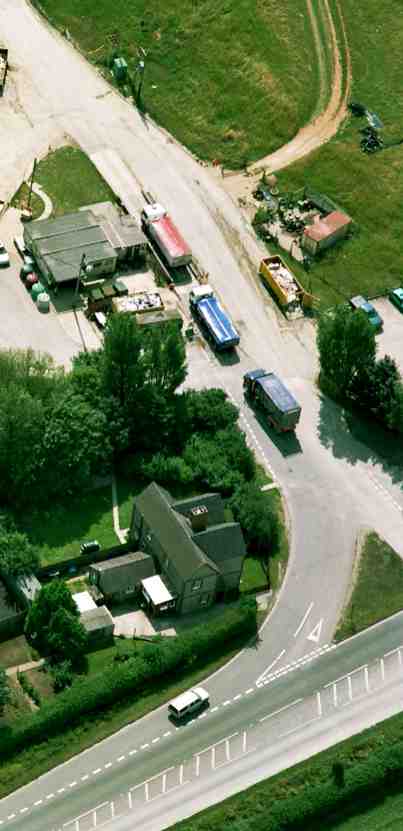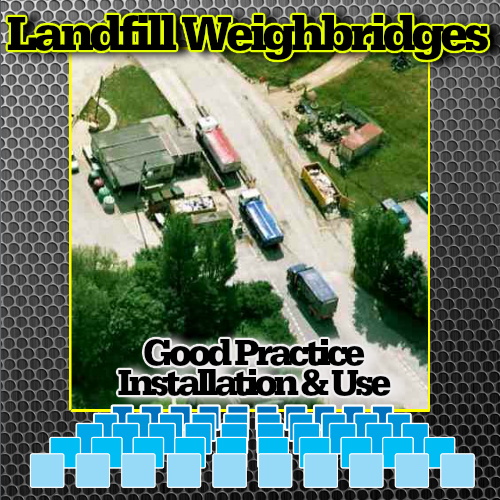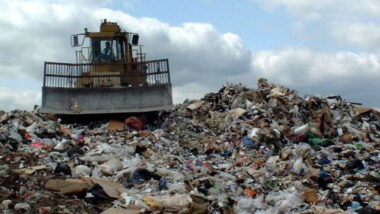For any well run landfill site the accurate recording of waste inputs is essential for effective management of the site, and is be required by most national waste management regulations, to enable verifiable returns to be made to the waste regulatory body.
Good Practice for Landfill Weighbridge Layouts
On site weighbridges are the best way of providing such data.
Further weighbridge considerations are that:-
It is good practice to weigh the vehicles both on entry and exit from the site.
Single weighbridge installations are common on small sites to average input rate sites. Twin weighbridges become necessary to avoid excessive queuing for waste input rates above 100,000 tpa input rate, but the cut-off point at which a second bridge becomes necessary will be closely related to peak traffic arrival rates;
Twin weighbridges may be located on either side of an island on which a single weighbridge office is situated, in which case two weighbridge clerks may need to be employed during peak periods only, and a single clerk would be on duty during quieter periods managing traffic on both sides.
Weighbridges as an Anti-Corruption Measure
Bribery of site staff to accept unrecorded loads can almost certainly be practically eliminated by the provision of weighbridge facilities.
Vehicle movements across the bridge are recorded and unpaid movements then become visible to management. Rising barrier systems can be used if necessary, which do not allow vehicles to move off the bridge until the transaction has been recorded.
Some site operators log each load delivered against a 3D location reference for the active tipping cell position into which the waste will be delivered. In that way they could, if ever needed, return to that position and (at least in theory) dig the material back out for testing, removal etc.
Weighbridge Layouts and Traffic Flow Considerations

The weighbridge should be located sufficiently far from the highway to provide space for queuing off the main highway to avoid tailbacks on to the highway. Computer modelling packages based upon historical site vehicle arrivals patterns, or where arrivals are derived from probability theory, are available to assist with such assessments.
Sites with large input rates which require twin weighbridges may need the provision of specific queuing lanes. The weighbridge office will normally be located on the offside of the weighbridge. It should be positioned so that the weighbridge operator can easily see vehicles approaching, leaving and using the weighbridge. The office should be elevated so that the weighbridge operator can speak to the vehicle driver.
Care should be taken to design for safety in all weighbridge layouts. The activity of vehicles reversing causes many accidents, and thus reversing should be minimised within the chosen sit layout.
If reversing is unavoidable, site layouts should be chosen so that the driver of the vehicle turning during reversing is always turning back into the driver’s field of vision.
When choosing layouts for the weighbridge(s) and access roads always take care to allow adequate turning space.
Computer Assisted Design (CAD) packages can be set up to trace out the swept-curves for each type of vehicle axle layout, or alternatively cardboard cut-outs made to scale and then laid on the drawing will serve the same purpose.
Night floodlighting illumination levels at the weighbridge(s) will be high for safety reasons.
On many sites a system of Tare, whereby for the vehicles regularly visiting site, the software holds a record of the unladen vehicle weight. Under such systems the need to weigh each vehicle again on the way out of the site after tipping, may be waived.
Choice of Weighbridge Type
Considerations for choice of the type of weighbridge selected for a specific landfill site appllication:
1. Platform weighbridge – flush with the road
Advantages
No ramps are required, and the vehicle can be turning while it moves on to the bridge, as long as by the time the vehicle cab has run fully onto the bridge it has aligned itself parallel with the line of the weighbridge. Therefore flush mounted weighbridges can be very useful on sites which are cramped/suffer from area restrictions.
Disadvantages
- Once installed, relocation is difficult. The foundation substructure is a large part of total weighbridge installation cost and cannot be moved.
- Man access beneath the weighbridge is required, sufficient for the safe working of operatives for the clearance of debris and mud which may accumulate.
- If built on in-filled area, settlement may occur and access could be restricted unless appropriate engineering measures are undertaken.
- As the bridge is sunken to be flush with the road surface, the essential draining of the area below the weighbridge may be much more difficult, especially on flat sites where the requirement for a sump pump may be unavoidable.
2. Platform weighbridge – raised
Advantages
- Easy to install
- Less engineering work required
- Moveable and can be relocated at reasonable cost.
Disadvantages
- The bridge is some 350 mm, or more, above road surface and, therefore, ramps are required.
- When the area needed for ramps is considered, then usually the essential site weighbridge area will footprint will be larger to allow for the ramps.
3. Axle weighers
Advantages
- low cost
Disadvantages
- Not all types are suitable where accurate weighing is required
- Traffic Control
The operator may need to control traffic using the weighbridges by means of traffic lights or a lifting barrier. The site layout should be designed for easy communication between the drivers. The weighbridge office should be provided close to the weighbridge, together with the means for the exchange of tickets at a window, with suitable shelter and lighting. Alternatively, the drivers will need to enter the weighbridge to present their details and make payment at a desk.
Weighbridge Software and IT Systems
Computer based technology applied to weighbridges increases:-
- efficiency, and removes concerns regarding temptations in respect of possible corrupt entry of some vehicles.
- the free flow of traffic to and from the site.
- the quality of the data collected.
The introduction of a weighbridge without the provision of a computer based system to collect data on tonnages of material, types of material etc., and allow site or head office billing, is rightfully now rare.
Modern weighbridges should almost always now be linked to a computer which will record the identity of the carrier and the size and nature of the load. Although designed primarily to facilitate billing, their recording systems provide a valuable basis for more detailed waste input records:-
- Methods of data acquisition and transfer include magnetic cards, bar code readers, and vehicle mounted transponders.
- These are principally suitable for regular site users. The facility to deal with occasional loads must also be included.
- The best of the current weighbridge software packages are now integrated with the internet via modems or DSL/ADSL, with dedicated secure web sites continually updated in real-time on the worldwide web to show delivery progress, and account balance to regular site users, haulage managers etc.
- Security of the weighbridge office is an important consideration. Services (electricity, telephone and possibly water and drainage) will be required.
Weighing Facility Maximum Design Loading
To handle the full range of road-going disposal vehicles, the weighbridge should be able to weigh up to 50 tonnes gross vehicle weight (UE max. vehicle loading may be subject to change). Weighbridges used at landfill sites are commonly 15 m long and 3 m wide.
Contact Us here if you require assistance with the design of the site layout for your weighbridge facility.
Ramp Method of Waste Disposal – Landfill Guide & Techniques
The ramp method optimizes landfill operations by creating an inclined surface, allowing efficient waste compaction and daily cover application. Unlike traditional methods, it requires minimal excavation, reducing costs and extending landfill lifespan. Proper implementation and equipment maintenance are key to effective ramp method performance in various terrains…
Inert Waste Acceptance Criteria
Inert Waste Disposal and the Requirements for Acceptance Testing The definition of inert waste in the UK, is very restricted by the waste regulations to ensure that when inert waste is disposed to land it will not produce pollution as contaminated groundwater or polluted run-off. This is important as substantial volumes of inert waste remain which […]
Bulldozers Vs Landfill Compactors For The Best Waste Compaction Density
Managing waste at landfills needs proper compaction. Many waste managers struggle to pick between bulldozers and landfill compactors for this job. However, an experienced landfill operator knows that these machines are used best to serve different roles in waste management. Read on because choosing the wrong machine can lead to wasted void space and higher […]
Understanding the Benefits and Drawbacks of Sanitary Landfill Sites
In this article, you will find out about the advantages and disadvantages of sanitary landfills. Deciding on the best way to handle rubbish, is a common challenge, especially in developing nations. Sanitary landfills offer one solution, but they come with pros and cons. This article will help you understand these landfill sites better, including their benefits and drawbacks. Stay […]











Many thanks. This is truly a useful page. So useful that I decided I must register my satisfaction to find such useful information given freely. Keep up the good work!
The latest weighbridge systems feature automatic number plate recognition, swipe card access, traffic barriers and a ticket printer so the driver leaves with a full record of the transaction.